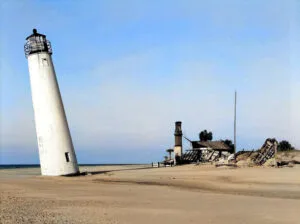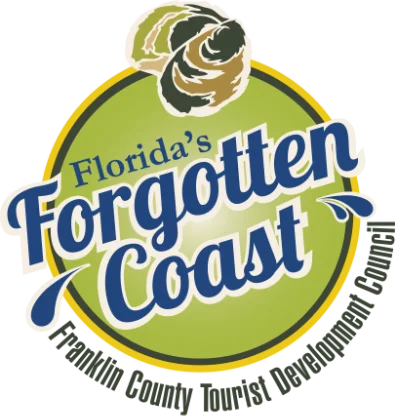You are here: Home > Franklin County Maritime Heritage Museum >
Beacons of History – Franklin County Lighthouses
Franklin County boasts two restored lighthouses. The first is located on St. George Island. The second is located at Carrabelle Beach. Each tells a tale of coastal living in Franklin County more than 100 years ago and each is worth visiting.
Cape St. George Light
 The Cape St. George Light, which stands at the center of St. George Island, is the fourth reconstruction of the historic lighthouse that was originally built on what is now Little St. George Island. The first lighthouse was erected in 1833 near West Pass but was difficult for maritime traffic approaching from the east to see.
The Cape St. George Light, which stands at the center of St. George Island, is the fourth reconstruction of the historic lighthouse that was originally built on what is now Little St. George Island. The first lighthouse was erected in 1833 near West Pass but was difficult for maritime traffic approaching from the east to see.
After suffering storm damage, it was ultimately dismantled and its bricks were used in the construction of a new tower, completed in 1848 at Cape St. George. The second lighthouse fell during a hurricane in 1851. The third lighthouse was completed in 1852, again using materials from its predecessor, but positioned further inland from the water’s edge. For 153 years the Cape St. George Light valiantly served mariners well, but beach erosion ultimately caused its collapse on October 21, 2005. In a dramatic team effort involving private contractors, local volunteers, and government funding, the pieces of the Light were salvaged and moved to a storage site on the mainland. The St. George Lighthouse Association acquired the 1852 plans from the National Archives and led the effort to reconstruct the lighthouse on St. George Island. Volunteers cleaned old mortar off the salvaged bricks, and more than 22,000 original bricks were used in the rebuilding effort. Original granite door jambs and window lintels were re-installed in the reconstructed lighthouse. The iron lantern room, twisted beyond hope in the fall, was reforged using the original pieces as patterns. With extensive community support and public and private funding, the Cape St. George Light was successfully rebuilt and opened to the public on December 1, 2008. A replica of the original Lighthouse Keeper’s House, built next to the lighthouse, features a museum and gift shop. Museum exhibits include the lighthouse history and artifacts. An audio-visual “interactive archive” provides visitors access to videos, photographs and documents relating to the lighthouse.
Crooked River Lighthouse
 For nearly 100 years the Crooked River Lighthouse in Carrabelle stood as a guiding light for ships, and fishermen navigating the treacherous pass between Dog Island and St. George Islands. Today the lighthouse and keeper's house museum stand on the mainland where the light was originally built in 1895, replacing the three short-lived beacons destroyed by hurricanes on Dog Island.
For nearly 100 years the Crooked River Lighthouse in Carrabelle stood as a guiding light for ships, and fishermen navigating the treacherous pass between Dog Island and St. George Islands. Today the lighthouse and keeper's house museum stand on the mainland where the light was originally built in 1895, replacing the three short-lived beacons destroyed by hurricanes on Dog Island.
The 103-foot iron and steel structure was decommissioned by the Coast Guard in 1995 and is listed on the National Register of Historic Places. The Carrabelle Lighthouse Association and the City of Carrabelle obtained ownership of the landmark from the Coast Guard just weeks before it was scheduled for auction and the organization created a public park surrounding it. Public and private financial support enabled the restoration of the structure to be completed in 2007. Nestled in a north Florida forest habitat the lighthouse beams nightly, complete with the original restored 4th order Fresnel lens. The park picnic area features a replica of the Crooked River Lighthouse Keeper’s House which was patterned after the original 1895 plans. The Keeper’s House serves as a museum, gift shop and headquarters for the CLA. Exhibits include an historical setting of the early 1900s, examples of beacons and the methods of constructing a skeletal tower lighthouse. Everyday life objects in the Keeper’s Room include original clocks, a barometer, a glass fire grenade, pages from the keeper’s watch book, currency and much more. Visitors can look through replica Sears catalogs for a perspective on cost of living during the past century. Group educational tours are welcome and new science-based programs are being developed.
Dog Island Lighthouse

Photo provided by Bill Price & the Florida Department of State Photo Archive
In 1837, Congress appropriated $10,000 for the construction of a lighthouse on the western end of Dog Island, marking the eastern side of the entrance to St. George's Sound. The lighthouse and keepers’ quarters was located on five acres deeded from the Apalachicola Land Company to the United States. The fifty-foot, brick tower was constructed directly on the sand and was first lit on March 1, 1839. Just three years later, a hurricane caused the bottom portion of the tower to cave in, and a replacement tower made of wood was hurriedly erected to take its place. This second Dog Island Lighthouse also had a short lifespan. A hurricane in 1851 flattened it and about everything else on the island. The third lighthouse built on the island was another brick tower, which rose to a height of forty-eight feet. This lighthouse survived the Civil War, but received significant damage at the hands of occupying Union soldiers. In 1873 this third tower also fell victim to a hurricane. Money was appropriated for yet another lighthouse on Dog Island, but due to the slow recovery of the Southern economy following the war, it was never built. In 1888, the Lighthouse Board requested a change in the language of the already approved appropriation for the replacement lighthouse on Dog Island, and the wording was altered the following year to read that the lighthouse could be constructed “on or near Dog Island, or specifically on the mainland to the westward of the Crooked River in Franklin County, Florida.” In 1895, work on the Crooked River lighthouse began.

